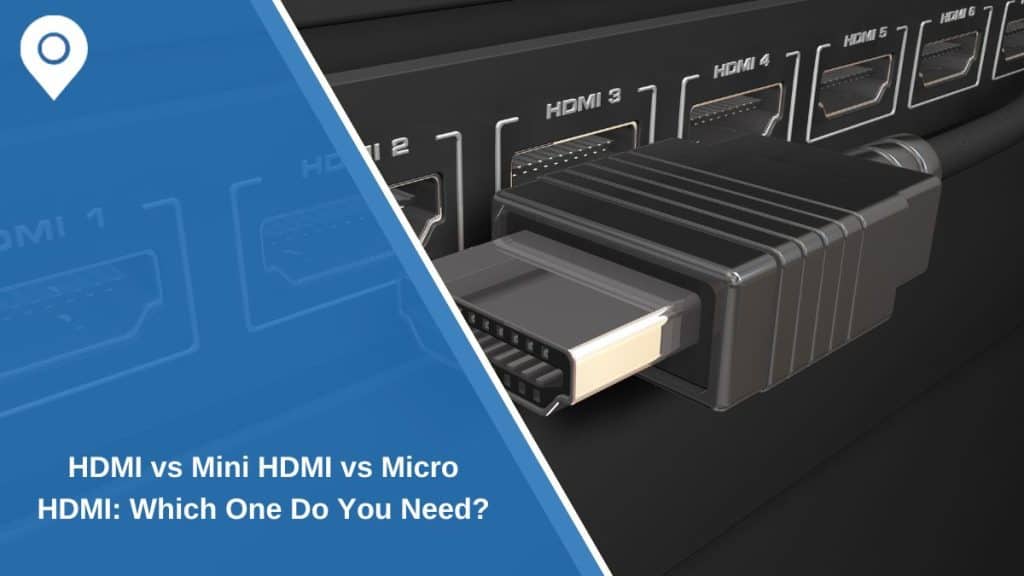HDMI is one of the most common ways to connect devices like TVs, monitors, laptops, and gaming consoles. It carries both high-definition video and audio through a single cable, making it simple and reliable. But not all HDMI connectors are the same. Alongside the standard HDMI, there are also Mini HDMI and Micro HDMI ports that show up on smaller devices. Knowing the difference helps you pick the right cable or adapter and avoid frustration when setting up equipment.
What Is HDMI?
The standard HDMI connector, known as Type A, is the full-size version most people recognize. It measures about 14 mm wide and is found on TVs, monitors, desktop PCs, gaming consoles like Xbox and PlayStation, and many laptops.
HDMI has become the industry standard because it supports both audio and video in one connection. It handles resolutions from 1080p to 4K and even 8K, depending on the version. Features such as HDMI ARC and eARC also allow audio to flow back to sound systems and home theaters.
What Is Mini HDMI?
Mini HDMI, or Type C, is smaller than standard HDMI but still carries the same signal quality. At 10.42 mm wide, it was designed for devices where space is limited but video output is still needed.
You’ll commonly find Mini HDMI ports on DSLR cameras, camcorders, some tablets, and lightweight laptops. With an adapter or a Mini HDMI-to-HDMI cable, these devices can connect to TVs or projectors just like a standard HDMI device.
What Is Micro HDMI?
Micro HDMI, or Type D, is the smallest HDMI connector at just 6.4 mm wide. Despite its size, it transmits the same high-quality video and audio signals as larger HDMI types.
It is usually found on smartphones, action cameras like GoPro, and compact tablets. Manufacturers include it to save space while still giving users the ability to output video to larger screens. As with Mini HDMI, adapters and special cables make it compatible with standard HDMI ports.
Comparing HDMI, Mini HDMI, and Micro HDMI
The differences between these three connectors are mostly about size and the devices they’re used on.
- Size: HDMI is the largest, Mini HDMI is smaller, and Micro HDMI is the smallest.
- Devices: Standard HDMI is common on TVs, monitors, and consoles; Mini HDMI on cameras and tablets; Micro HDMI on smartphones and action cams.
- Signal quality: All three carry the same digital video and audio signals. There is no quality loss based on connector size.
- Adapters: Both Mini and Micro HDMI can connect to regular HDMI ports with adapters or special cables.
- Durability: Smaller connectors are more fragile and easier to damage if plugged and unplugged frequently.
Compatibility and Adapters
Compatibility is not a problem as long as you have the right cable. A Mini HDMI-to-HDMI cable connects cameras directly to TVs. A Micro HDMI-to-HDMI adapter allows a phone or GoPro to connect to a projector or monitor. These adapters are widely available and inexpensive.
HDMI Versions vs Connector Types
It’s important to separate HDMI versions from connector types. Versions like HDMI 1.4, 2.0, and 2.1 refer to performance features, including supported resolutions, refresh rates, and bandwidth. Connector types (HDMI, Mini HDMI, Micro HDMI) only describe the physical shape and size of the port.
That means a Mini HDMI cable can support 4K if it is built to the right version, just like a standard HDMI cable.
When to Use Each Connector Type
Each type of HDMI port has its place:
- Standard HDMI (Type A): Best for TVs, monitors, consoles, and most PCs.
- Mini HDMI (Type C): Common in DSLR cameras, camcorders, and some tablets.
- Micro HDMI (Type D): Found in action cameras, smartphones, and compact tablets.
All three work the same way once connected, but the device determines which port is used.
Troubleshooting Connection Issues
Sometimes HDMI connections fail even when using the right cable. Problems usually come from small issues:
- Loose or damaged cables.
- Wrong adapter type.
- Device not set to the correct output resolution.
- Ports clogged with dust or debris.
- Using uncertified or low-quality cables.
Checking these simple points usually restores a working connection.
Conclusion
HDMI, Mini HDMI, and Micro HDMI all transmit the same digital video and audio signals. The only difference is size, which is why smaller devices use Mini or Micro ports. With the right cable or adapter, they connect seamlessly to TVs, monitors, and projectors. Signal quality does not depend on the connector type, so choosing the right one is about matching the port on your device.
If you’ve ever struggled with a connector mismatch, share your experience. Your story might help someone else understand the difference and find the right solution.
